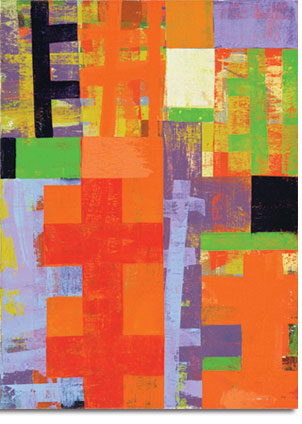Mar 2009

Since 2002, when he moved from a landscape-based style into
rectilinear abstraction, oil painter G. Lewis Clevenger has been exploring the
permutations of the grid. Working within defined parameters, he has evolved his
style slowly but satisfyingly, introducing at least one new textural,
compositional, or chromatic wrinkle into his schema with every successive show.
In "New Paintings," the three-time Oregon Biennial selectee reaches for and
attains his greatest expression of freedom and inventiveness to date. The
breakthrough owes largely to the irregular diagonal lines and scrawly
cross-hatching he infuses into his otherwise starchy squares and rectangles. In
works such as Straw House and the aptly named Terra Nueva (New
Ground), the graphic quality and thick sensuality of the lines takes on a volume
more suggestive of Matisse's gouache cut-outs than Mondrian's grids. You can see
the rigidity of Clevenger's formula giving way in Brick House, in a blue passage
that starts out hard-edged but lightens and dissolves as it sweeps leftward. The
squeegee-like, rubber-tipped knives that the artist paints with in lieu of
brushes enable him to control the pressure and precision of his application,
much as a calligrapher does by altering the angle of the nib. The artist clearly
relishes these effects; he may even be having fun.
As in the past,
Clevenger's inspiration derives from a long-standing interest in mid-century
modernist architecture, in particular the ranch home. Nearly all his paintings'
titles refer to homes, and in a sense, the compositions function as psychic
blueprints into which viewers may project themselves, inhabiting the planes as
if they were rooms. Indeed, there is something of a Richard Neutra/Palm Springs
clarity in the color palette as well, with its bright, sunny blues, desert-like
earth tones, and bracing jolts of palm-frond green. For all their vibrance, the
colors are not monolithic in presentation, however. In Stick House,
striations of chartreuse and orange peek out from under swaths of lavender,
betraying layers of crackly, creamy texture that lend the pieces an air of
weathering or excavation. Across the show as a whole, there is a feeling that
the artist is increasingly willing to contemplate decay: to set up his
immaculate grids, only to look on, knowingly, as their pure colors blanch and
their pristine regularity degrades into chaos.
“Stick House,” 2008, G.
Lewis Clevenger Oil on canvas, 30" x 221⁄2"
Photo: Dan Kvitka, Courtesy
of Pulliam Deffenbaugh Gallery
